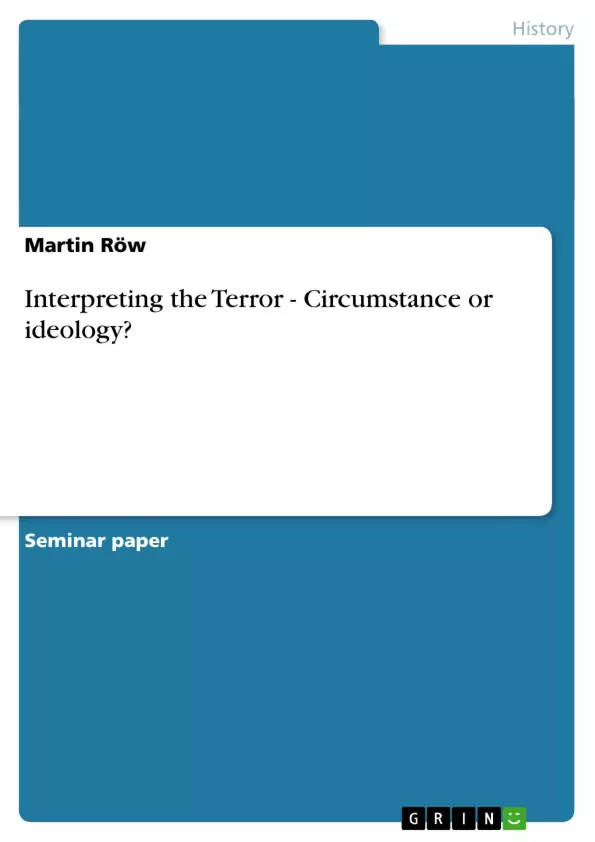The Terror of the French Revoltion has devided the world of scholars right from the
beginning. It is a crucial issue which was often connected with emotions and political
attitudes, when it was approached. Many questions rose when relating the violence and the
Terror with the genuine ideology of the French Revolution. Was it a part of it right from the
beginning? Or shall we see the Terror as an accident incompatible to democracy and the
origins of the French Revolution? This essay attempts to depict the reasons for the terror
with the aim to be able to judge the Terror. To judge means to be able to distinguish between
different sorts of Terror and to place the judgement into the scholarly discourse. The
depiction will leave out the description of developments but rather pick certain events and
breaks to show why and how Terror was used. Furthermore the essay will leave out the end
of the `Great Terror` as well as the `White Terror`.
Inhaltsverzeichnis (Table of Contents)
- Introduction
- The scholarly discourse
- Popular Terror
- Circumstances
- Turn of the tide
- Conclusion
- Bibliography
Zielsetzung und Themenschwerpunkte (Objectives and Key Themes)
This essay explores the French Revolution's Terror, examining its causes, development, and relationship to the Revolution's ideology. The essay aims to analyze the Terror by distinguishing between different forms and situating its development within the scholarly discourse. It analyzes specific events and breaks to demonstrate how and why the Terror was used. The essay focuses on the period before the "Great Terror" and does not include the "White Terror."
- Interpreting the French Revolution's Terror
- Different scholarly perspectives on the Terror
- The role of popular violence in the early stages of the Revolution
- The circumstances leading to the "Great Terror" under the Committee of Public Safety
- The relationship between the Jacobins and the sans-culottes
Zusammenfassung der Kapitel (Chapter Summaries)
- Introduction: The essay introduces the central question of the Terror's connection to the French Revolution's ideology, presenting the ongoing debate among scholars. It highlights the essay's aims, including analyzing the Terror, distinguishing its different forms, and examining specific events.
- The scholarly discourse: This section outlines three main camps of scholarship: "right-wing" scholars who condemn the Terror, "circumstance" historians who explain it through historical context, and "Revisionists" who argue that the Terror was an inherent aspect of the Revolution's ideology.
- Popular Terror: This chapter explores the early stages of the Revolution, focusing on popular uprisings and acts of violence, including the storming of the Bastille and the September Massacres. The essay distinguishes this early "Terror from below" from the later "Great Terror" imposed by the government.
- Circumstances: This chapter examines the circumstances leading to the "Great Terror," emphasizing the Revolution's internal and external threats, such as the First Coalition, the Vendée uprising, and the demands of the sans-culottes. It analyzes the tensions and differences between the Jacobins and the sans-culottes.
Schlüsselwörter (Keywords)
The primary keywords and focus topics of the text include the French Revolution, Terror, ideology, scholarship, popular violence, circumstances, sans-culottes, Jacobins, Committee of Public Safety, September Massacres, and the "Great Terror".
- Quote paper
- Martin Röw (Author), 2004, Interpreting the Terror - Circumstance or ideology?, Munich, GRIN Verlag, https://www.grin.com/document/38202



